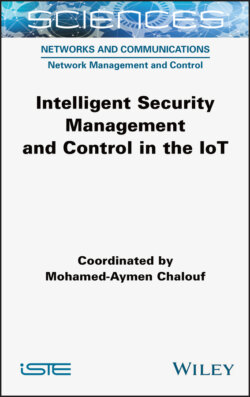Читать книгу Intelligent Security Management and Control in the IoT - Mohamed-Aymen Chalouf - Страница 43
2.2.3. Radio resource random access procedure
ОглавлениеThe NPRACH channel has been completely rethought in NB-IoT not only to improve network coverage and energy consumption but also to adapt to the narrow bandwidth of NB-IoT (Lin et al. 2016). Indeed, in LTE the PRACH channel alone occupies more bandwidth than NB-IoT occupies in its entirety (1.08 MHz vs. 180 kHz).
Each NB-IoT terminal wishing to connect or resynchronize at the base station on the uplink after a long period of inactivity should execute a random access procedure. The first stage of this procedure consists of transmitting a preamble sequence on one of the frequency bands periodically allocated to the NPRACH channel. This is called Random Access Opportunity (RAO).
Figure 2.3. Structure of a preamble sequence. For a color version of this figure, see www.iste.co.uk/chalouf/intelligent.zip
The preamble consists of a set of four groups of OFDM symbols, as illustrated in Figure 2.3. This is the MCL, targeted by the standard, which determines the number 4. Each group of symbols is formed of a cyclical prefix (CP) and of K data symbols. To maintain the orthogonality of random access transmissions over different sub-carriers, the CP should be long enough to palliate long round trip times, especially in cells as large as those targeted in NB-IoT (up to 35 km) (3GPP 2015). The higher the number K , the more the overhead generated by the CP is reduced. On the contrary, K should be kept small so as to control interferences. In NB-IoT, K is fixed at 5 and two CP lengths are defined for both formats of the NPRACH channel, that is, 266.7 μs and 66.7 μs (Lin et al. 2016; 3GPP 2020).
For the purpose of extending coverage, the preamble can be repeated k times (k = 2i, i= 0, …, 7) (3GPP 2019b). The preamble sequence sent by the terminal is, consequently, formed of 4 × 2i group symbols. The network can thus define up to three different configurations of the NPRACH resource per cell, depending on the classes of coverage considered. The number of repetitions k is fixed times = 0, is thus defined for each of the configurations.
Each group of symbols is modulated over a different sub-carrier to the others. The NPRACH channel uses only single tone mode with a spacing of 3.75 kHz. A frequency band of up to 48 sub-carriers can thus be allocated to this channel with a base band of 12 sub-carriers. Thus, 12, 24, 36 or 48 contiguous sub-carriers are allocated to this channel in each coverage class. Consequently, the terminal has 12, 24, 36 or 48 orthogonal preambles and chooses one at random to transmit.
In addition, as illustrated in Figure 2.3, NB-IoT defines two jump models in the frequency band allocated to the NPRACH channel: (1) a fixed model for the jumps between the different groups of symbols forming the same preamble and (2) a pseudo-random model for repetitions of this preamble.
Thus, within a preamble, a frequency jump is applied between the first and the second group symbols and between the third and the fourth symbols. Another jump of six frequencies is also applied between the second and the third group of symbols. The pseudo-random model is, for its part, applied though by choosing start sub-carrier indexes from different repetitions of the preamble, by taking the cell identifier and the number of repetitions expected (Lin et al. 2016) as input data.
The random access procedure in NB-IoT, illustrated in Figure 2.4, is an exchange in four stages between the terminal and the base station (3GPP 2018b):
– the terminal transmits the preamble chosen at the first RAO opportunity and sets a timer for reception of the RAR response;
– if the preamble is clearly detected by the base station, the latter sends an RAR response conveying the timing advance and the allocated resource;
– the base station performs conflict resolution and sends the identity of the winning terminal in the conflict resolution message. If the message does not arrive at the terminal, the terminal continues to await it until the timer expires;
– the terminal then sends a connection request, by using the resource allocated to it and again sets a conflict resolution timer. This request, named msg3, conveys in particular the terminal identity.
Figure 2.4. Random access procedure
This procedure fails if the terminal does not receive one of two responses from the base station in the windows of time defined by the two timers. Collisions between preambles, sent by different terminals, are often the cause of failure. In fact, if two terminals or more choose the same preamble on the same ROA opportunity, each will see its access attempt fail.
Each terminal for which the access procedure has failed observes a wait time chosen at random in a predefined interval and then retransmits its preamble. The number of retransmissions permitted depends on the terminal coverage class. If this number is reached and the terminal still does not succeed with the access procedure launched, this latter goes into the following coverage class if there is one or ends with a definitive failure of the access procedure.
